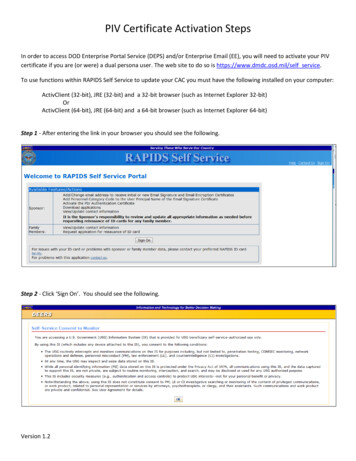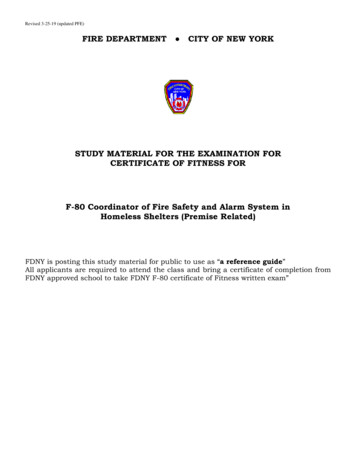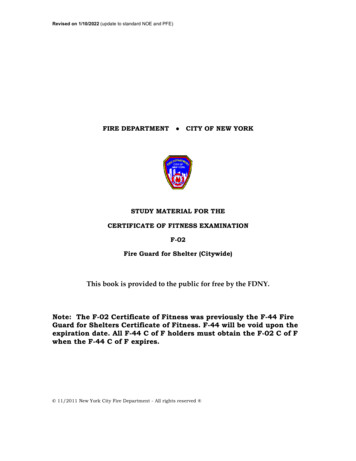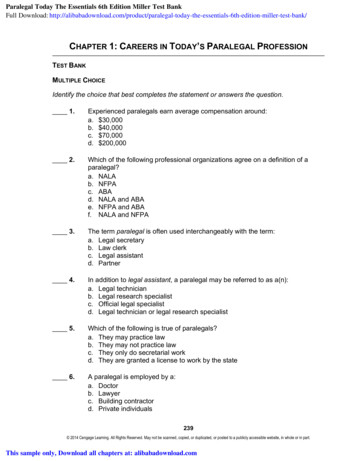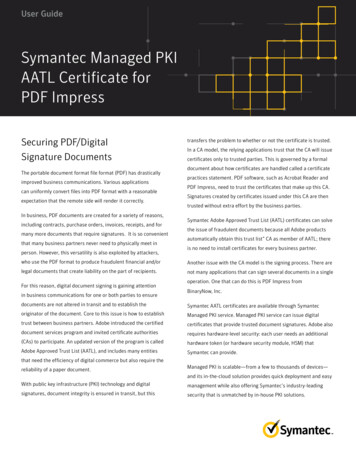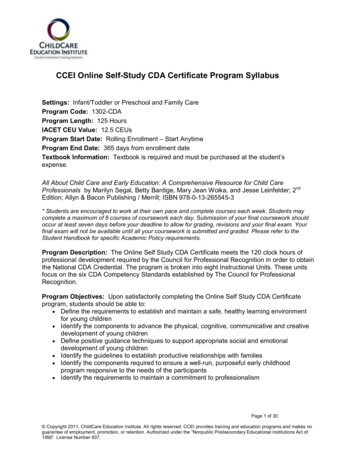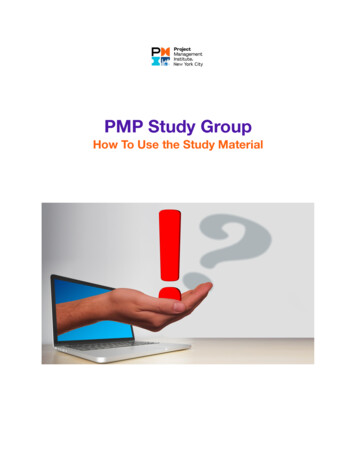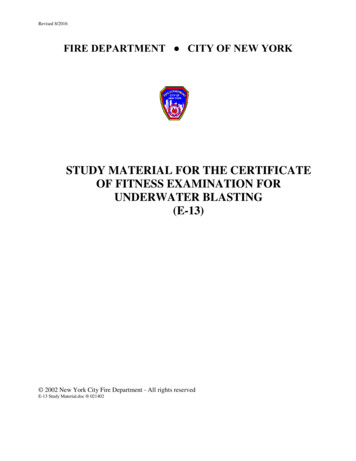
Transcription
Revised 8/2016FIRE DEPARTMENT CITY OF NEW YORKSTUDY MATERIAL FOR THE CERTIFICATEOF FITNESS EXAMINATION FORUNDERWATER BLASTING(E-13) 2002 New York City Fire Department - All rights reservedE-13 Study Material.doc 021402
NOTICE OF EXAMINATIONTITLECertificate of Fitness for Underwater Blasting (E-13)To qualify and make an appointment: paperwork must be submitted in advance to Explosives Unit:Explounit@fdny.nyc.govDATE OF TEST: By appointment only Monday through Friday (except legal holidays) 8:00 AM to 12:00PM.REQUIREMENTS FOR WRITTEN EXAMApplicants who need to take the exam must apply in person and bring the following documents:1. Applicants must have a reasonable understanding of the English language.2. Applicant must provide two forms of identifications; at least one form of identification must begovernment issued photo identification, such as a State-issued Drivers’ License or Non Driver’sLicense or a passport.3. Applicants must present a letter of recommendation from a union and/or employer acceptable to theFDNY Explosives Unit. The letter must be on official letterhead, and must state the applicant’s fullname, experience and the address where the applicant will work. If the applicants are self-employedor the principal of the company, they must submit a notarized letter attesting to their qualifications.For more info: Sample of recommendation df/business/cof-samplerec-letter.pdf 4.5.6.7.8.9.Sample of self-employed s must present a completed application for certificate of fitness (A-20 f/business/cof-application-form.pdf2 Passport Size photosFingerprinting Fee: 89.75 (Money Order)Resume detailing experienceCopies of any Explosives related licenses, training courses/certificates or other Certificate of Fitnessfrom NYC or alternate jurisdictions.Special requirement for the E-13:a. US Citizenb. Must be 21 years of agec. Possess E-14 Certificate of Fitness for at least 1 year. Proof must be provided before takingthe test.d. submit two notarized letters from two FDNY E-10 or E-13 Certificate of Fitness holdersattesting to their experience.APPLICATION FEE:Pay the 25 application fee in person by one of the following methods: Cash Credit card (American Express, Discover, MasterCard, or Visa) Debit card (MasterCard or Visa) Personal or company check or money order (made payable to the New York City FireDepartment)A convenience fee of 2.49% will be applied to all credit card payments.2
EXAM INFORMATIONSpecial Note: Exam will also consist of a series of verbal questions.Call (718) 999-1988 for additional information and forms.Please always check for the latest revised booklet at FDNY website before you take the /business/cof-e13-noe-studymaterials.pdfIf all the requirements are meet and pass the exam a certificate will be issued the same day. Applicant whofails the exam will receive a failure report. To retake the exam applicants will need to submit a newapplication and payment.RENEWAL REQUIREMENTSAll renewals must go through the Explosives Unit in order to verify criminal background.Please note that in person renewals are not recommended. Call the Explosives Unit for more information.E-13 Certificates of Fitness are valid for a period of one year from the date of issuance. At the end of thisperiod, the certificate expires unless the commissioner approves its renewal. Please be advised thatcertificate renewals shall be at the discretion of the commissioner in the interest of public safety. Thedepartment may review the certificate holder’s qualifications and fitness. E-13 holders must ensure that theiroriginal Certificate of Fitness card is available for inspection at all times by the FDNY.The renewal fee is 5. FDNY also reserves the right to require the applicants to take a re-examination uponsubmission of renewal applications. Certificate of Fitness can be revoked at any time.You may receive a courtesy notice of renewal 90 days before the expiration date. However, it is yourresponsibility to renew your Certificate. It is very important to renew your C of F before it expires.Renewals submitted 90 days (up to one year) after the expiration date will incur a 25 penalty in addition tothe renewal fee. Certificates expired over one year past expiration date will not be renewed a new exams willbe required.To change a mailing address:Submit a letter requesting the change of mailing address and a copy of your C of F and a 5.00 fee.To change a work location,Submit a letter from your current employer (on company letterhead) confirming that you are an employeeand stating your new work location with a copy of your C of F and a 5.00 fee.To request a replacement certificate:Submit a driver’s license or passport, social security number and mailing address and a 5.00 fee.The certificate can be renewed On-line or Mail.3
Renewal onlineIf you are an individual, make sure you have your 12 digit Certificate of Fitness Access ID. This can befound on your Renewal Notice. If you do not have your Renewal Notice, your Access ID is your 8 digitCertificate of Fitness number and the last four digits of your social security number. If you are submittingrenewals on behalf of a company's employees, the company must be approved by FDNY and have an 8 digitCompany Code. To request approval, email pubrenew@fdny.nyc.gov.Renewal fee can be paid by one of the following methods: Credit card (American Express, Discover, MasterCard, or Visa) Debit card (MasterCard or Visa) E-checkIf all the requirements are met, the certificate of fitness will be mailed out within 10 days.For online renewal go to: https://a836-citypay.nyc.gov/citypay/FDNYCOF Renewal by mailMail your Renewal Notice (or if you did not receive a Renewal Notice, a copy of your certificate), alongwith your fee payment, Personal or company check or money order (made payable to the New York CityFire Department)NYC Fire Department (FDNY)Cashier's Unit9 MetroTech Center, 1st FloorBrooklyn, NY 11201If all the requirements are met, the certificate of fitness will be mailed out within four to six weeks.FDNY Explosives Unit reserves the right to require applicants to take a re-examinationupon submission of renewal applications.4
EXAM SITE:FDNY Headquarters, 9 MetroTech Center, Brooklyn, NY. Enterthrough the Flatbush Avenue entrance (between Myrtle Avenueand Tech Place).5
This study material will help you prepare for the written examination for the Certificates of Fitnessfor Underwater Blasting (E-13). This study material includes information taken from the FirePrevention Code and the Fire Prevention Directives of the Bureau of Fire Prevention, NYFD. Thestudy material does not contain all of the information you need to know in order to work safelywhen storing, handling, or using explosives. It is your responsibility to become familiar with allapplicable rules and regulations of the City of New York, even if they are not covered in thismaterial.You must pass both a multiple choice test and an oral test to qualify for the Certificate of Fitness.You must pass the multiple choice test before you take the oral test. A passing score of 70% isrequired in the multiple choice test. All questions on the multiple choice test have four alternativeanswers. Only one answer is correct for each question. If you do not answer a question youranswer will be scored as incorrect. Read each question carefully before marking your answer. Youcan always come back to "REVIEW" your answers. There is no penalty for guessing on themultiple choice test.Sample Questions1. All explosives and blasting caps must be stored in:(A) the blaster's truck.(B) a magazine.(C) the site supervisor's shed.(D) underground vaults.The correct answer is "B". You would tap alternative "B" on your answer computer screen.2. The word "EXPLOSIVES" painted on the rear of a truck carrying explosives must bepainted in which color?(A) Black.(B) Red.(C) Green.(D) White.The correct answer is "D". You would tap alternative "D" on your answer computer screen.6
STORAGE, HANDLING AND USE OF EXPLOSIVESThe key to preventing explosives accidents is to follow proper blasting procedures. Safe blastingpractices must be followed at all times. Safe practices are required from the moment explosives aredelivered to the magazine to the inspection that is made after the blast.There are several kinds of persons who work with explosives. It is important that each personknow and understand what they are permitted to do. A person working with explosives shouldnever try to do something that they have not been trained do. Every person who works withexplosives must have a Certificate of Fitness. A person should not do anything with explosivesunless they have a Certificate of Fitness for what they are doing.The Blaster is the most highly qualified person at the blasting site. The blaster has totalresponsibility for the use of explosives and record keeping. The blaster has responsibility for thesafety of the public. The blaster is responsible for all work with explosives. The blaster plans theblasting work, supervises loading of the blast, and is responsible for setting off the blast. Only theblaster may give permission to fire a blast.The Powder Carrier is essentially an "apprentice" blaster. The powder carrier helps to load holeswith explosives. The powder carrier assists the blaster in preparing primer cartridges and in wiringcharges.Explosives Loaders help the blaster in tunnel and shaft work. The explosives loader helps load thetunnel face to prepare for the blast.Explosives Handlers are the drivers of the trucks used to deliver explosives to the blast site.Explosives handlers are responsible for the safe transport and handling of explosive materials andrecord keeping pertaining to pick-ups and deliveries. They are not permitted to do any other workwith explosives.The Magazine Keeper accepts delivery of explosives at the work site. The magazine keeper keepsrecords of explosives as they are received and used. The magazine keeper is responsible for thesafe keeping of explosives in the magazines. Magazine keepers are not permitted to do any otherwork with explosives.StorageAll explosives and blasting caps must be stored in magazines specially made for that purpose. Amagazine must be approved and have a permit to store explosives. Magazines must be under thedirect supervision of a magazine keeper holding a Certificate of Fitness. The only duties of themagazine keeper are to guard the magazine and to maintain accurate records.The magazines must be kept locked when they have explosives or blasting caps in them. Themagazines should be unlocked only when materials are delivered to the magazine, or are removedfor delivery to the blast site. Only the magazine keeper, the blaster or the powder carrier may haveaccess to the keys to the storage magazines.7
Accurate records of all explosive materials must be kept. These records are required to meet theregulations of the Fire Department of New York City. Separate records are required for blastingcaps and sticks of dynamite. The picture below shows the form that is used for blasting caps.The blasting cap record shows when blasting caps were received at the job site. The record alsoshows who received the blasting caps and how many blasting caps were delivered. The recordshows when any blasting caps were taken from the magazine to be used in a blast.Blasting Cap RecordThe picture below shows the record that is kept for sticks of dynamite. The record keeps track ofwhen explosives were received and when they were taken out. This way all explosive materials areaccounted for at all times.Dynamite Record8
The blasting cap record and the dynamite record are kept in the magazine. The records must besurrendered to a duly authorized Fire Department representative when requested.Only the amount of explosives that will be used for the next blast that is being loaded should beremoved from the magazine. Any explosives that are not used for the blast must be returned to themagazine as soon as possible. Explosives taken from the magazine should be carried only in theiroriginal containers or special carrying boxes. The original containers or special carrying boxesshould be used to return unused explosives to the magazinesThe magazines must be kept clean. Areas within 25 feet of the magazines must be kept clean andfree of all rubbish. Dead grass and shrubbery and other obstructions must be removed. Emptycartons, packing materials and other combustible materials pose a dangerous fire hazard. Smoking,open flames, matches, lighters, etc. are prohibited inside or within 50 feet of a storage magazine.Persons should not be permitted to loiter in the area near the magazine.The amount of explosives that may be kept in a magazine depends on the class of the permit for themagazine. The permit must be kept in the magazine and ready for inspection. The classes ofmagazines and the maximum amount of explosives that may be stored are as follow.First ClassSecond ClassThird ClassFourth ClassFifth Class1,000 pounds500 pounds250 pounds100 pounds25 poundsExplosives and blasting caps may not be kept in the same magazine. Two separate magazines arerequired. One magazine is used to store explosives. Another magazine is used to store the blastingcaps. The magazines for explosives and blasting caps should be at least 100 feet apart. A specialvariance is required if the magazines must be closer than 100 feet apart.The Superintendent, the Blaster and the Magazine Keeper must inspect the magazines at the end ofeach work day. They must also inspect the job area and the carrying boxes. After the inspectionthey must sign the Blasting Cap Record and the Dynamite Record. Any explosive materials thatwere not used during the day must be returned to the vendor.Whenever a magazine keeper is relieved by another magazine keeper, both should inspect themagazine. They should check the explosives on hand and both sign the Magazine Record Slip ineach other's presence. The Magazine Record Slip should be kept in the magazine. The MagazineRecord Slip should be given upon request only to an authorized representative of the FireDepartment. The condition of the magazines are inspected regularly by representatives from theFire Department. These inspections are also recorded on the Magazine Record Slip. Theillustration on the next page shows the Magazine Record Slip.9
Magazine Record SlipTransportationOnly specially designed vehicles may be used to transport explosives. All vehicles used totransport explosives in New York City must have a permit. Two persons holding Certificates ofFitness as explosives handlers must be on each vehicle transporting explosives. This is in case oneperson is injured, becomes ill, etc. The explosive handlers are responsible for seeing that thevehicle is in safe operating condition. They must also check that proper fire extinguishingequipment and flags are in place. Smoking while transporting explosives is strictly prohibited.Matches, lighters or metal tools are also not permitted on any vehicle transporting explosives.Blasting caps and explosives may not be carried together on the same truck. If a job site needs tohave both blasting caps and explosives delivered two trucks must be used. If two trucks cannot beused the truck must make two trips. Explosives may be delivered only to an approved andpermitted site.Only three deliveries may be made to the same site in one day. The amount of one delivery to asite cannot be more than what is permitted by the class of the magazine. For example, a site with aFourth Class permit cannot receive more than 100 pounds of explosives in one delivery.The total amount of explosives that can be delivered to a job site in one day depends on the class ofpermit. The total amount that is delivered cannot be more than three times the amount permittedfor that site. For example, a site with a permit for a Third Class magazine may not receive a totalof more than 750 pounds of explosives in one day.A vehicle carrying explosives cannot have more than 1,000 pounds of explosives at one time. Nomore than 5,000 electric fuses or blasting caps can be carried at one time. A special permit isrequired if larger amounts must be transported. Vehicles used to carry explosives may not be usedto carry equipment or other supplies. Only the explosives handlers may ride on the truck. Otherpersons are not permitted on the vehicle.10
Blasting ProceduresOn a blasting job, the blaster has total responsibility for the use of explosives, record keeping andpublic safety. The blaster must ensure that only safe procedures are used. The blaster must alsomake sure that workers at the job site perform only those duties for which they have a Certificate ofFitness.Blasting must be done only between the hours of 7:00 a.m. and 7:00 p.m., or between the hours ofsunrise and sunset. Blasting may not be done during hours of darkness unless a special permit hasbeen granted by the Fire Commissioner. Blasting is done only on Mondays through Fridays. Aspecial permit is required to blast on Saturdays.Before loading of blastholes is begun, all equipment not required for the loading operation shouldbe removed from the blast site. Only authorized persons needed to perform the loading operationshould be allowed at the blast site.The primer or cartridge of explosive containing the detonator is generally loaded into the hole first.If there is no detonator well in the cartridge, space for the detonator is made by punching thecartridge with a nonsparking powder punch. The hole should be large and deep enough to be surethat the detonator is completely embedded in the primer cartridge. The detonator leads may betaped or tied to the cartridge with a half-hitch to complete the primer assembly. Detonators mustnever be forced into the explosive cartridge.After the primer cartridge is loaded, the detonator leads should be anchored at the collar of the hole.There should be enough tension to keep the leads against the wall of the drill hole. However, thereshould be enough slack to prevent excessive tension.All types of detonators are sensitive to accidental initiation by heat or impact. Detonators shouldbe handled carefully and protected from excessive heat. Electric detonators are also sensitive toextraneous electricity. This could come from radios, high voltage power lines, or electrical storms.For this reason all blasting operations should be suspended when an electrical storm approaches.Blasting operations should not begin again until the storm has completely left the area. Electricdetonators should be checked before primer cartridges are made up.Blasting charges should be tamped only with wooden or plastic tamping rods. The explosivesshould be pressed or set into place only with a steady, even pressure. No tamping rod should beused if it is frayed or split at the end.Only one blast at a time should be loaded on the same rock face or heading. Special precautionsmust be taken when blasting near buildings or utilities. The closest to public utilities blasting maybe done without consulting the NYFD Explosives Unit is 25 feet.After blastholes have been loaded the detonators should be checked to be sure that they have notbeen damaged before any stemming is begun. If there is a possibility that the primer system hasbeen damaged, a backup primer should be loaded into the hole.11
Stemming should be done carefully to ensure that downlines or legwires are not damaged.Stemming material should be relatively clean and free flowing. Large rocks or any combustiblematerials should not be used for stemming blastholes. After blastholes are stemmed, all excessexplosive materials and empty packaging materials should be removed from the blast area. Thisshould be done before actual hookup of the blast is begun. Unused explosives should be returnedto the storage magazine. During the hooking up of the blast circuit only those persons required tocomplete the tying in of the holes should remain in the basting area. The wiring of the blastingcircuit should be under the control of the blaster in charge.A shot should be fired as soon as possible after loading is completed. An audible blast warningsignal must be given before the shot is fired. The following signals are used.One long whistle Preparing to blastTwo whistles .Ready to blastThree short whistles .All clearThe warning procedure should be familiar to all personnel working in or near the blasting area.The warning procedure should be posted where it can be easily seen.At least three (3) minutes before a blast, the blaster should also position workers at every approachto the blast site. These workers should have a red flag. They are used to warn people and to keepunauthorized persons away from the blast site. Signs reading "NO RADIO TRANSMITTING"should also be posted in the area surrounding the job area.After the hole has been loaded and tamped, the blast face must be covered on all exposed sides.This will help to prevent injury from flyrock resulting from the blast. The blast face must becovered with a strong woven matting of rope or wire. The rope or wire must be at least one andone-half inches in diameter. Persons on the blast crew required to be near the blast site when theblast is fired must be provided with adequate protection. Personnel must not be directly in front ofthe blast face at the time of firing, no matter how far away they are.Only the blaster should connect the shooting wires to the switch box. The blaster is responsible forthe actual firing of the blast. The blaster is also responsible for the safe keeping of the box orswitch used to fire the blast. Before hooking the blasting circuit into the leading line, the lineshould be checked with a galvanometer to assure continuity of the circuit.In tunnel or subway work, the blaster is the last person to leave the job after the loading iscompleted and the wires are connected. Only the blaster is permitted to throw in the electric switchto fire the blast. In open work, the blaster may direct an assistant to fire the blast. The blast shouldbe fired only after all preparations have been made and safety precautions taken.In tunnel or subway work, only the blaster or powder carrier may ride with explosives on the shaftcage or powder car. After a heading has been loaded, any unused explosives should be returnedimmediately to the main magazine.12
Workers should not return to the blast area until all smoke, fumes and dust have cleared. The blastsite must be inspected by the blaster before an "ALL CLEAR" is given. Workers should not returnto the work area until an "all clear" signal is given. In tunnel or subway work, the waiting time issometimes referred to as "smoke time." The amount of time allowed is usually about 20 minutes.Before the "ALL CLEAR" signal is given special attention should be given to any evidence ofmisfires or unexploded materials. The muckpile should be inspected for any explosive materialsthat might be burning.A misfire is the failure of an explosive charge to detonate at the proper time. Misfires are besthandled by adequate planning and preparation. This will help prevent misfires from happening inthe first place. When a misfire occurs all personnel should stay out of the area until it is safe toreturn. The power source used to fire the initiation system must be disconnected from the firingline. After the firing line is shunted or made safe, the blaster may enter the blast area to inspect themisfire. Any suspected unfired detonators or explosive materials should be treated as if they werelive explosives.Any explosives not used during the day must be returned to the vendor. If any unused explosivescannot be returned at the end of the day or before dark, the Bureau of Fire Prevention ExplosivesUnit must be notified. After the last shot has been fired for the day on a job, the Fire Departmentshould be notified. This is done by calling the fire company responsible for the area where themagazine is located. Arrangements will be made for an inspection.Shot RecordsThe blaster must keep a record of all shots made under his supervisions during his working shift.The shot record is kept on the form shown in the illustration on the next page. This form isprovided by the Fire Department. The shot record shows the number of sticks and caps receivedfrom the magazine. The Shot Record indicates the date and time of each shot. The Shot Recordshows the number of sticks and caps that were actually shot. The record shows what was done withany sticks and caps that were not used in a blast.Blaster's Shot Report13
The shot record must be signed by the work site superintendent, the blaster, and the magazinekeeper at the end of each day's work. The shot records are kept in the magazine for inspection bythe Fire Department Blasting Inspector or other authorized representative.FIRE EXTINGUISHERSThe user of explosives must be familiar with the different types of fire extinguishers that arepresent. The user must know how to operate the extinguishers in a safe and efficient manner.He/she must know the difference between the various types of extinguishers and when they shouldbe used. The three classes of fires and the right kind of extinguishers are described below.Class A fires occur when ordinary combustible materials are ignited. For example, wood andpaper fires are classified as class A fires. Water type extinguishers should be used to extinguishthese fires. The water type extinguishers cool the fire while quenching the flame.Class B fires occur when flammable liquids or greases are ignited. These fires must extinguishedby smothering the flame. The flame may be smothered using CO2, dry chemical or foamextinguishers. Water type extinguishers are not effective for class B fires.Class C fires occur when electrical equipment catches fire. These fires must be fought with fireextinguishers that do not conduct electricity. CO2 and dry chemical extinguishers must be used toextinguish electrical fires. Foam and water type extinguishers must not be used to extinguishelectrical fires.Examples of Water type, CO2 and Dry Chemical extinguishers are shown below.Typical Fire Extinguishers14
Symbols may also be painted on the extinguisher. The symbols indicate what kind of fires theextinguishers may be used on. Examples of these symbols are shown below.Typical Symbols Painted on Fire ExtinguishersThe symbol with the shaded background and the slash indicate that when the extinguisher must notbe used. The explosives user must understand these symbols.Generally, operation instructions are clearly painted on the side of the fire extinguisher. Theyclearly describe how to use the extinguisher in case of an emergency. Examples of theseinstructions are shown below.Operation Instructions for a Fire Extinguisher15
magazine must be approved and have a permit to store explosives. Magazines must be under the direct supervision of a magazine keeper holding a Certificate of Fitness. The only duties of the magazine keeper are to guard the




